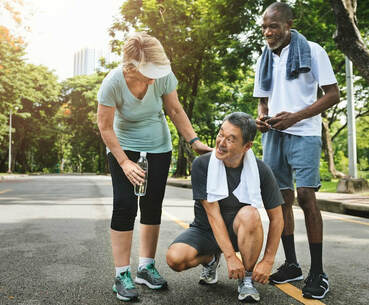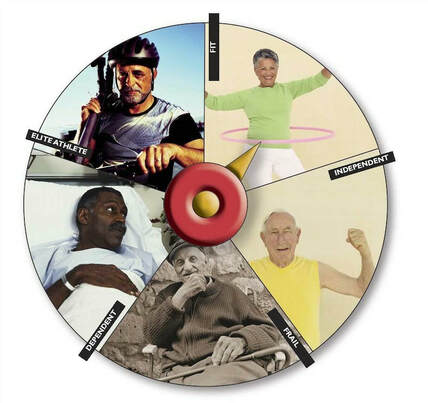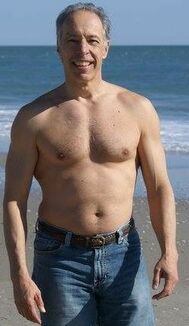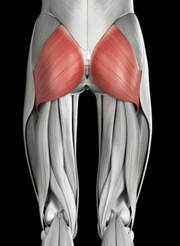 Here’s Why the Glutes Are So Important Sometimes, after a few weeks of working out together, a client might ask, “Why do we do so much glute work?” “Glutes” is the technical term for rear end. So you might translate that question as, “What’s my butt got to do with it?” Either way you put it, the answer is the same: A lot. The gluteus maximus rules as the largest muscle in your body, the hub of movement, the workhorse. Problems arise when your glutes get lazy or dormant because other muscles must kick in to perform jobs that they're not designed to do. And that starts a domino effect of compensations that will, over time, wreak havoc on your body. With every step you take, your glutes should absorb much of the impact and propel you into the next step. If your glutes can’t do that, your foot, knee, hip, back – maybe even your neck – are going to take the brunt of those forces. And because your glutes are at the center of your body, they’re crucial to function for both the lower and upper body. At any age, if the butt starts lagging, you’re far more likely to experience back pain and have knee trouble. You’re also more prone to falls, which is a particular concern for mature adults. And, at any stage in life, no one wants a saggy bottom. That's why we monster walk, squat, deadlift, and perform other exercises to strengthen your glutes, including bridges, plank variations, and banded hip abductions. Did I mention the monster walk ... the Yogilates Rx class favourite? Your butt is just too important to ignore.
0 Comments
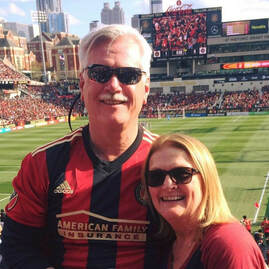 The couple that exercises together stays together! Just ask Steve and Lisa Jones, who work out at a gym three times a week and hike or run two other days. They’ve been married 40 years and happily recall their Valentine’s story when they met as teenagers. "It was instant chemistry, love at first sight," Steve, 63, recalls. "We've never looked back." Lisa, 62, continues, “I got in my car and told my friend, ‘Oh, my God, am I in love?’” They still enjoy doing things together, including exercise. Since they started working out 12 years ago, they’ve never faltered in their enthusiasm or habits. 5 Reasons It Works Research shows there are good reasons we should all be keeping up with the Joneses on this. Psychology Today reports five ways working out together can help a romantic pairing.
Strong motivations Steve and Lisa got started in fitness a dozen years ago. The impetus was Lisa’s realization that she had slowly become obese. Lisa, a schoolteacher, then took up exercise and changed her diet, losing 94 pounds in the first five years. (She has kept it off even longer than that.) Steve, who works in construction supply, joined her. His parents both lived into their 90s and enjoyed good fitness and health. “I decided, if I’m going to be that old, then I want to be able to do things I enjoy, and not just sit around all the time.” They keep each other accountable and prod each other to success at the gym, where they work on strength, cardio and core. They each have separate interests, too, in addition to their work lives. But they simply love each other’s company, after all these years – including in the gym. “We’re best friends,” Lisa says. “It’s worked for us, all this time. We just enjoy being together.” In fitness and in health. Happy Valentine’s Day. 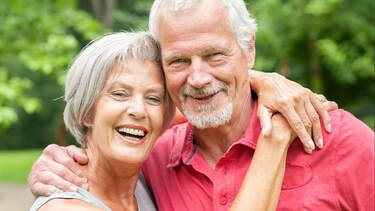 We usually think of February as the month of hearts for Valentine’s Day. But February is also Heart Month, promoted by the Heart and Stroke Association, to raise awareness and to help people lose weight, eat better, invigorate their exercise routines and more. Heart disease is the No. 1 killer in North America. The good news: Heart disease can be prevented. Exercise and eating right are the top tools to improve our heart health and lower our risk for heart disease and heart attacks, according to the Heart and Stroke Association For people over 50, exercise, including strength training, is vital. As most people age, their hearts get smaller and weaker, and major arteries can stiffen. That reduces or slows blood flow through the body. The best prevention is to exercise throughout life. But it’s never too late to start to gain some of the benefits. This New York Times article explained some of the latest research in detail. Weightlifting among mature adults improves heart health by decreasing blood pressure and “bad” cholesterol, while improving “good” cholesterol. Exercising and eating right also fight obesity, which contributes to heart issues. 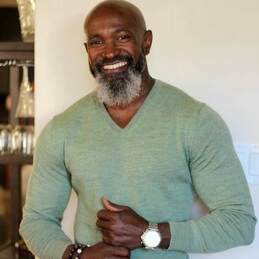 “Reinvent yourself” is a modern mantra for countless North Americans. In the years since digital disruption and the economic recession, we still see proof all around us. So many North Americans are creating the next chapters of their lives in or near retirement, or to begin a new line of work or hobby. If we all write the story of our lives, then sometimes we have to turn a page. Jean Titus, 50+, has experienced that in the last 10 years or so. The former investment adviser began developing his own business projects after the 2008 economic downturn. His mother passed away, after warning him about eating too much to fuel his overzealous bodybuilding. And a chance meeting with a former professional athlete made him realize he had let his physical performance fall below his expectations for himself. "I started getting serious about this when I realized I wasn't doing my best, and I wanted to do better," he recalls. "I saw loved ones die or get sick because they hadn't taken care of themselves and realized how easy it is. "I decided I was going to do better. I didn't know what that meant exactly, but I knew I could go out every day and just keep pushing it." “I didn’t say, ‘I’m too old; that’s too difficult.’ Those things didn’t enter into my mind. I just have figured out how to do it. And that’s the approach I want people to have – especially people in their 50s." “Once that wrench goes in, their thinking process has to stop and reboot. They come out with a whole new way of looking at what’s possible.” Writing Your Own Act 2 Most of us won’t want to achieve Titus’s level of bodybuilding or be able to reach it. But that doesn't matter. Your personal fitness goals are just as important, no matter what they are. And, as Titus would say, those goals are not only possible but attainable. Many good articles and resources are online for anyone wanting to write their own Act 2. Here are a few:
If your Act 2 means tweaking your fitness routine or reinventing yourself physically, come in and let’s talk about what you want. Even after 50, many people want to have new experiences and gain different perspectives – and life sometimes guides us toward changes whether we want them or not. Design Fitness Centre can help you get to your own “what’s possible” through exercise. Will Rogers once said, “Even if you’re on the right track, you’ll get run over if you just sit there.” It’s a nice, homey metaphor. It’s also true literally, according to a pair of new studies that say movement is the key to longevity as well as physical and mental health. The first study showed that aerobic exercise (walking or biking, for instance) for just six months can begin reversing cognitive decline. And if it’s combined with a proper diet, the combo can reduce the brain’s functional decline, according to the report in the American Academy of Neurology. That experiment was performed on middle-aged people. Another one focused on people in their 70's and 80's. Published in the journal Neurology, findings said the risk of dementia is cut by physical movement – any movement. Even simple housework like cooking and cleaning can make a positive contribution. "Exercise is an inexpensive way to improve health and our study shows it may have a protective effect on the brain," says Dr. Aron S. Buchman with Rush University Medical Center in Chicago, who led the study. These findings might not be headline-making, but they’re still relevant, especially when trying to get mature adults to exercise regularly. For instance, earlier research has shown that walking 45 minutes three days a week can increase brain volume among people over 65. And really – no one is publishing any scientific studies that say being a couch potato is good for you. On the spectrum of physical ability, where do you rank?
More importantly, where do you want to rank? Let’s look at a five-point scale. Most people over 50 fall into one of these categories.
We’ll look at each in more detail below. But take a guess now which one applies to you. How does that make you feel? Surely no one wants to think of themselves as dependent or frail – and everyone’s fitness goals are different, ranging from healthy function to high-level sports competition. That’s what’s so liberating about a healthy lifestyle: It lets you live the way you want to live, whatever that means to you. Come in and let us help you enjoy getting to where you want to be or maintaining your fitness level in fun, new ways. Exercise is the best medicine – and, no, it’s not too late to start. From Elite to Dependent Here’s how the Functional Aging Institute breaks down the stages, with broad direction on how people in each group can benefit from small group training. It’s a good structure to begin a discussion. Elite Description: These are the most healthy and functional folks, those who are regular exercisers and probably involved in recreational sports. They have advanced physical abilities, and they love working hard at their fitness. Outlook: “Given their advanced physical abilities, there is really no limit on what they can do in a training session.” Fit Description: Most fit mature adults are considered fit in the area they train but might be deficient in other areas. Maybe a strong runner or cyclist has low strength, or a strong man has poor flexibility. There's such a big range here that FAI notes the distinction between "fully fit" and "semi-fit." Outlook: “They need a heavier focus on the specific areas in which they are deficient.” Independent Description: The average mature adult can perform daily tasks on their own, but they don’t participate in any vigorous activities. This is the largest category, and some mature adults get trapped in complacency here, thinking that their independence means they don't need to exercise. But that can lull them into a dangerous place, where one fall or injury can knock them down to "frail" or "dependent" status. Outlook: “This group needs a well-rounded mix with a focus on increasingly complex movements and those that challenge dynamic balance.” Frail Description: People at this stage have low functional abilities in most or all aspects – strength, poor balance, energy, etc. They need help performing everyday tasks. Outlook: “They require an emphasis on basic strength and power exercises, as well as basic gait and mobility patterns. Balance movements should be more static and performed with caution because they have a high risk of falling.” Dependent Individuals in this group typically require specialized one-on-one assistance and are not candidates for group classes. Everyone is different We know that you’re an individual, not a member of a demographic or even a subset on a scale like this. Functional fitness doesn’t necessarily track with chronological age. If you don’t know a super-fit 80-year-old, you’ve seen examples of them in the media and in my studio. And, sadly, it’s more likely that you know, perhaps, someone who is 60 and frail. We are here to help you get or stay fit by your own definition, for your own purposes. Those might include independence, fitness and maybe even elite athleticism way more than frailty and dependence. 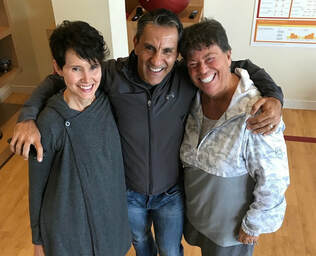 Are you a Debbie Downer? Or do you go around humming “Don’t Worry, Be Happy” all the time? And which do you think is better for your health – a negative attitude or a positive one? Yep, it should be obvious. And it’s also true. Studies show that optimism is good for our physical and mental health, as well as our longevity.
Exercise helps. Simply by moving our bodies, we put ourselves in a better mood. And by maintaining strength, agility and endurance, we build upon our happiness every day. So, go for a walk, ride a bike, lift weights, run, swim, hike, practice yoga, dance – whatever you like. Need more?
Sources: Journal of Personality and Social Psychology, John’s Hopkins, WebMD 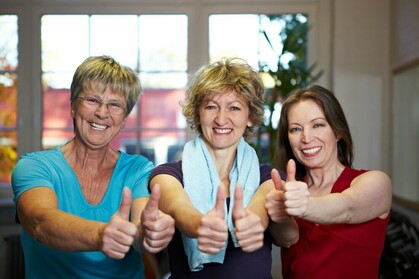 We’re still in January, far too early to even think about giving up on healthy habits for the year. Whether you made a resolution to get fit or just renewed your commitment to exercise and to eat right, we’re here to keep you going throughout the year with these 19 reasons to stick with it in ’19.
Over the year, be sure to stay up to date on activities here and throughout the community so you can make plans and set different goals. Maybe you’ll walk, ride or run a charity 5K or longer race and need time to get ready for it. Or you want to build up your stamina for a dancing event or summertime hike. Or maybe you’d like to slim down for a wedding or other big family gathering. Whatever your motivation, I'm here to help you reach your goals – and have a good, safe, healthy time while you’re doing it. Let me know what motivates you. And don’t be shy to say when you need a little extra encouragement some days. 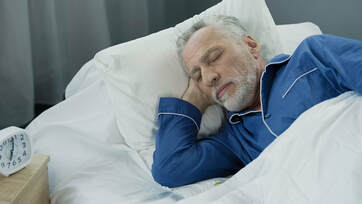 Sleep is so important any additional information related to the topic is worth a reminder of it's relevance to our overall health. Weightlifting has countless health benefits for people over age 50, all throughout life. Resistance training for mature adults keeps us from losing muscle mass as we age. You might already know that it helps with weight loss, balance, blood pressure, and mood. Did you also know that it helps with sleep, too? Just one session of resistance training helps us fall asleep faster, studies show. One session helps what’s called “sleep consolidation,” or the brain’s ability to store memories and learning. Weightlifting also improves general sleep quality. And it reduces the severity of sleep apnea, improving sleep and reducing disruptions that create chronic tiredness. The relationship between resistance training and sleep works conversely: Good sleep is essential for exercise, too. Here are some other tips for ensuring a good night’s rest;
Sources: WebMD, IDEA Health & Fitness Association Have you ever heard the old saying, “The horse is out of the barn”?
It’s a folksy way of telling someone it’s too late to make a change. It’s also one of the myths about fitness after 50 that we love to bust every chance we get. And here’s a great example of someone who has done so, Joe Robert Weaver. Joe was almost 60 when his teenage son asked him for information about exercise. Since Joe had never much cared for training, he had a lot to learn – and he finally decided to get into shape along with his son. Joe lifted heavy weights and quickly packed on 30 pounds – muscle, yes, but fat, too, since he was eating so much after lifting heavy weights. (That’s when he took the “before” photo on the left, above.) He changed his way of eating, switched to lighter weights, and adopted a nasal breathing technique that he says gave him more energy. Excellence after 50? And then something amazing happened for Joe, who is now 67. “I got shredded!” he says. Joe’s abs appeared for the first time in his life at 60. “I didn’t even know they were there,” he says. Joe entered a physique contest for men over 40 and took second place. That busts yet another myth – that people over 50 can only maintain their previous fitness level or just hope to slow inevitable decline. But a rippling torso -- for the first time -- at 60? You bet. Of course, that might not be your goal. Maybe you'd like to get stronger, improve your golf game, avoid falling or enjoy playing with the grandkids... The list goes on and on, but the point is the same. Whatever your goal is, exercise can help you achieve it. Joe’s Top 3 Tips for Getting Started;
“Excessive strength and endurance aren’t that important for most people,” Joe says. What matters most in building balance, strength and endurance after 50? For him, Joe says it’s moderation in the dining room and consistency with your exercises in the gym. “It shouldn’t be boring or too hard,” he found about working out. “I like my exercise to feel good during and after the workout. When I first started out, I wondered if people were going to think I was crazy.” Now, Joe hopes his myth-busting success serves as an example: “You can accomplish whatever your goals are.” Come talk to me about your own fitness goals and how to bust a myth or two you’ve heard about exercise. We don’t guarantee rippling abs like Joe’s, but we definitely will make it fun. Promise. |
|
Contact TERRY |
SubscribeJoin our mailing list today!
|
